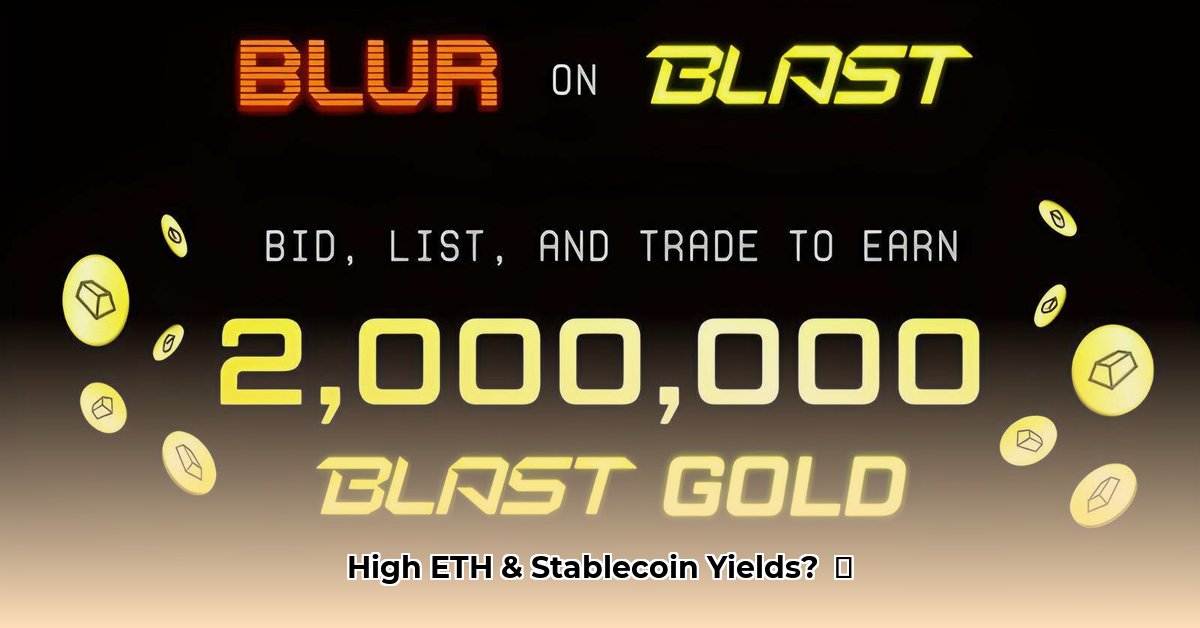
Blast NFT Marketplace isn't just another NFT platform; it's a Layer-2 scaling solution for Ethereum designed to accelerate transactions and generate yield on ETH and stablecoins. This article provides a technical deep dive into Blast Protocol, examining its architecture, risk profile, and competitive landscape, without focusing on its NFT marketplace features.
Technical Deep Dive: How Blast Works
Blast Protocol operates as a Layer-2 scaling solution (a system built on top of Ethereum to improve speed and efficiency), offering significant advantages over the Ethereum mainnet. Its key innovation is the integration of yield generation mechanisms, leveraging established DeFi protocols like Lido and MakerDAO.
This integration allows users to earn interest on their ETH and stablecoins passively. For ETH, Blast utilizes Lido's staking services, while stablecoin yields are generated through MakerDAO's T-bill protocol. This dual-yield approach offers potentially attractive returns: approximately 3% APY on ETH and up to 7.2% APY on stablecoins, significantly higher than many competing Layer-2 solutions. Crucially, Blast maintains Ethereum Virtual Machine (EVM) compatibility, enabling seamless integration with existing Ethereum-based applications.
However, this reliance on external protocols introduces inherent risks. If Lido or MakerDAO experiences issues (technical glitches, security breaches, or regulatory challenges), it could directly impact Blast's yield generation capabilities and user funds. This dependence highlights a critical vulnerability that necessitates careful consideration.
Risk Assessment: Understanding the Potential Downsides
Several key risks are associated with Blast Protocol:
Smart Contract Vulnerabilities: Like any software, Blast's smart contracts are susceptible to bugs and exploits. Rigorous security audits and bug bounty programs are crucial for mitigating this risk.
Third-Party Protocol Dependence: The platform's yield generation relies entirely on Lido and MakerDAO. Failures or disruptions in either protocol directly impact Blast's functionality and user returns.
Competitive Landscape: The Layer-2 space is highly competitive. Blast's unique value proposition – native yield generation – may not be sustainable without continuous innovation and adaptation.
Regulatory Uncertainty: The regulatory landscape surrounding DeFi is rapidly evolving. Changes in regulations could significantly impact Blast's operations and legal compliance.
Yield Volatility: The advertised yield rates are not guaranteed and are subject to market fluctuations. Users should anticipate variability in their returns.
Competitive Analysis: Blast's Unique Position
Compared to other Layer-2 solutions like Arbitrum, Optimism, and Polygon, Blast distinguishes itself through its integrated yield generation. While competitors primarily focus on improving transaction speed and reducing fees, Blast offers an additional incentive for users. However, this reliance on external protocols is also a significant weakness, creating substantial dependence on the stability and functionality of third-party services.
Stakeholder Analysis: Implications for Different Groups
The success of Blast Protocol depends on the alignment of various stakeholders:
Developers: Rely on Blast's tools and infrastructure to build and deploy applications, benefiting from increased transaction speeds and user engagement.
Users: Benefit from higher returns on their assets while enjoying faster and cheaper transactions.
Investors: Evaluate Blast's long-term growth potential, considering the risks associated with its reliance on third-party protocols.
Regulators: Oversee compliance with financial regulations and establish clear legal frameworks for DeFi platforms like Blast.
Conclusion: A Balanced Perspective
Blast Protocol offers a compelling proposition of high yields and faster transactions through its unique blend of Layer-2 scaling and integrated yield generation. However, substantial risks associated with smart contract security, third-party dependency, competition, and regulatory uncertainty must be carefully weighed. A robust mitigation strategy that addresses these limitations, coupled with a commitment to transparency and regulatory compliance, will determine Blast's long-term success. This article serves as informational material and does not constitute financial advice.
Disclaimer: This information is for educational purposes only and should not be considered as financial advice. Investing in cryptocurrencies and DeFi protocols carries significant risk, and you could lose money. Always conduct thorough research and consult with a financial advisor before making any investment decisions.